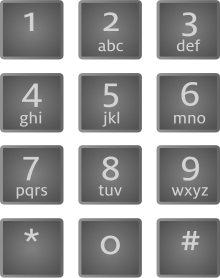Text on 9 keys
Text on 9 keys (in German: "Text on 9 keys"), T9 for short , is a patented system for easier text input ( input method ) on a mobile phone . It was invented by the Americans Clifford A. Kushler, Dale Grover, Martin T. King and Cheryl A. Grunbock and introduced in January 1998 by Tegic Communications Inc. (USA), a subsidiary of Time Warner AOL LLC. With the delivery of the Nokia 3210 , the technology was introduced in German-speaking countries in 1999. In June 2007, Nuance Communications Inc. acquired Tegic Communications.
functionality
Unlike most smartphones, keypad phones usually have a 12- key keypad with the digits 0 to 9 and two control functions for dialing numbers . For additional text input , the keys “2” to “9” are assigned three or four letters of the Latin alphabet . When entering text via this keyboard normally, the key must be pressed once or several times depending on the position of the desired letter.
To reduce the multiple keystrokes, during the operation with the "T9" system software control word suggestion of an integrated dictionary on the phone screen displayed and offered for adoption.
The T9 system makes use of the fact that each subsequent actuation of keys 2 to 9 only corresponds to a small number of meaningful words in a certain language , and longer sequences of digits often only correspond to exactly one word. Furthermore, if there are several possible letter combinations per key sequence, only a few are used frequently in everyday language.
A word is entered by pressing the corresponding number key only once for each letter. After each new entry, the software suggests the matching word with the highest frequency of use from the dictionary, if possible . If there are several options, one of the control buttons can be used to scroll through all suitable words. If a word is not in the dictionary (e.g. rare proper names), it can be added to the dictionary.
For example, the word house is written with the key sequence “4-2-8-7”: the mobile phone software initially offers the “I” (or “i”) for key 4, as the letters G and H are clear are used less individually. If the other keys in this sequence are then pressed, “Ha”, “Hat” and finally “House” appear one after the other.
advantages
The main advantage is that fewer key presses are usually required. In addition, the problem does not apply if two letters used one after the other are on the same key: Normally, between entering the individual letters, you either have to wait a short time or press a confirmation key.
To z. For example, to write the word "Hello", you have to press a key twelve times without T9 and take a longer pause or press the confirmation key:
- 4 4 2 5 5 5 Pause / confirmation 5 5 5 6 6 6
With T9 five keystrokes are enough:
- 4 2 5 5 6
disadvantage
T9 is for texts with many terms that are not part of the normal vocabulary , such as B. proper names , geographical information or dialect words are not suitable as these are not included in the T9 dictionary. In addition, the vocabulary of a mobile phone is sometimes very small, for example the words “brush” and “toothbrush” are unknown to the Nokia 6230i .
In addition, it can only be used for languages that are standardized and for which a dictionary exists. T9 is hardly used in German-speaking Switzerland, as Swiss-German , the usual SMS language in German-speaking Switzerland, does not have a standardized written language.
A further weakness are digit sequences for which there are two matching letter sequences that are both used with the same frequency and require corrections or scrolling with the control key. Examples:
| Digit sequence | 1st possibility | 2nd possibility |
|---|---|---|
| 3 7 | it | he |
| 8 6 7 | in front | us |
| 9 2 7 | was | What |
| 5 6 6 6 3 6 | can | come |
| 5 2 4 3 | location | hunt |
| 5 4 3 3 3 6 | walked | smoke weed |
| 5 4 3 3 3 7 | Songs | Stoners |
Some users find the use of the T9 system too cumbersome because B. requires more frequent scrolling between options or adding non-existent terms to the dictionary. Specially experienced users can sometimes enter texts faster without T9 despite the higher number of keystrokes.
Oddities
The German language version was " denazified ". In its original version, words like Volk and Nazi were shown as the first alternatives because they had a higher usage rate than the words Voll and Maxi in the company's internet research . In the meantime, however, the sort order has been changed and some words, such as B. Jewish question have been deleted from the T9 dictionary.
T9 can correct words that are not wanted by the operator, so that the changed word changes the overall context of the dialog and creates strange new meanings. Similar effects can be observed on smartphones with digital keyboards, where there are also unwanted auto-completions .
See also
Individual evidence
- ↑ Patent EP1256871 : Reduced keyboard disambiguating system. Published on November 13, 2002 , inventors: Clifford A. Kushler, Dale Grover, Martin T. King and Cheryl A. Grunbock.
- ↑ Michaela Schiessl: Nazi instead of Maxi . Mirror online. April 2, 2002. Retrieved January 28, 2010.
- ↑ autocompletefail.de of the T9 keyboards ( Memento of the original from October 10, 2011 in the Internet Archive ) Info: The archive link was inserted automatically and has not yet been checked. Please check the original and archive link according to the instructions and then remove this notice.
